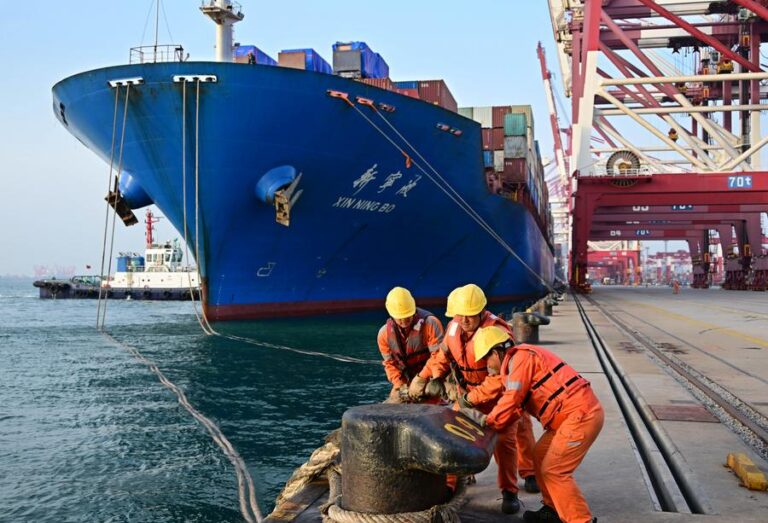The Version 3.0 China-ASEAN Free Trade Area (CAFTA) came at a critical moment, sending a clear and strong signal in support of free trade and open cooperation amid growing protectionism and trade fragmentation, analysts told Xinhua.
KUALA LUMPUR, May 27 (Xinhua) — In a significant stride toward regional economic integration, China and the Association of Southeast Asian Nations (ASEAN) countries have completed negotiations on an upgraded free trade agreement, doubling down on their efforts to promote inclusive and sustainable growth.
The Version 3.0 China-ASEAN Free Trade Area (CAFTA) came at a critical moment, sending a clear and strong signal in support of free trade and open cooperation amid growing protectionism and trade fragmentation, analysts told Xinhua on the sidelines of the ongoing 2025 ASEAN Summit and related summits.
The deal, a pivotal enabler for ASEAN and China’s sustained growth and competitiveness, marks a shift “from traditional goods to the future economy,” said Tan Kar Hing, deputy chairman of Malaysia’s Center of Regional Strategic Studies.
Beyond tariff cuts and smoother trade, the upgraded agreement incorporates nine new chapters covering such strategic areas as digital economy, green economy, supply chain resilience, small and medium-sized enterprise (SME) support and customs cooperation, reflecting “broader coverage and greater specificity,” the Malaysian expert said.
As major developing economies, China and ASEAN have been each other’s largest trading partners for years. Data from China’s General Administration of Customs showed that in the first four months, two-way trade reached 2.38 trillion yuan (330 billion U.S. dollars), up 9.2 percent from a year earlier. Their highly complementary economies form a cornerstone of regional cooperation.
For export-driven economies like Malaysia, the upgrade eases access to ASEAN and Chinese markets, particularly for small businesses. “Local SMEs can now connect directly with regional markets through digital platforms — true ‘local creation, regional expansion,'” Tan said. The pact also streamlines agricultural exports and builds traceable supply chains, key for Malaysia’s food and commodity sectors.
The evolution from Version 1.0’s basic tariff reductions to Version 3.0’s rule alignment signals a “deepening commitment to a high-level free trade agreement that is inclusive, modern, comprehensive and mutually beneficial,” said Tang Zhimin, director of China ASEAN Studies at the Bangkok-based Panyapiwat Institute of Management.
“By aligning rules, recognizing standards and enhancing mechanisms, the upgraded deal strengthens the foundation for collaboration in supply and industrial chains,” Tang said.
The inclusion of new priority areas in CAFTA 3.0 demonstrates the agreement’s responsiveness to pressing regional concerns, reflecting that “the China-ASEAN Free Trade Area is not static, but continues to evolve to address current and future challenges,” said Wijayanto Samirin, an economist at Indonesia’s Paramadina University.
More importantly, the upgraded free trade agreement signifies the resilience and growing strength of multilateralism against protectionism, the Indonesian analyst said. “It particularly underscores ASEAN and China’s support for multilateralism, injecting certainty into global trade.”
The pact highlights both sides as “steadfast supporters of economic globalization,” Tang said.
Thong Mengdavid, a lecturer at the Institute for International Studies and Public Policy of the Royal University of Phnom Penh in Cambodia said, “ASEAN and China are opting for openness over fragmentation.”
The deal also reduces reliance on Western markets. “It diversifies supply chains and reduces excessive dependence on specific export markets, thus enhancing autonomy and resilience for medium-sized economies like Malaysia,” said Tan in Malaysia.
Cambodia’s Thong added that it boosts the bloc’s “collective negotiating power on the global market,” calling ASEAN-China ties “a stabilizing force” amid global volatility. This is particularly significant given that China and ASEAN, as the world’s second and fifth-largest economies respectively, account for a quarter of the global population.
Unlike rigid Western trade pacts, CAFTA 3.0 emphasizes “inclusivity, flexibility and phased advancement,” Tan said, noting that its framework lets members tailor cooperation to domestic priorities. Malaysia, for instance, can fast-track projects in agriculture or green technology.
“This isn’t a one-size-fits-all model but a ladder for developing economies to climb at their own pace,” he said.
The pact’s completion reflects “unprecedented consensus” between China and ASEAN on institutional design, agenda setting and cooperation roadmaps, “evolving from basic tariff cuts to systemic rules,” Tan said, adding that it highlights “a renewed leap in political mutual trust and economic integration between the parties.”
Since its inception in 2010, the China-ASEAN Free Trade Area has become a template for South-South cooperation. “Its institutional innovations based on shared consultation and development continue to inspire and revitalize global governance,” said Tang. ■

